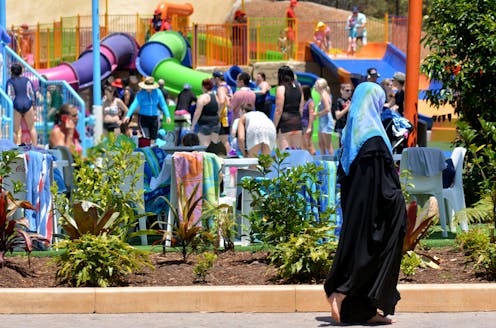New research shows how Australia's newsrooms are failing minority communities
- Written by Usha M. Rodrigues, Senior Lecturer in Journalism, Deakin University

Australians from culturally diverse backgrounds often feel frustrated about media coverage of news events and issues that portray them in a negative light. A new study analysing media coverage of issues related to multicultural Australia found that more than a third of stories reflected a negative view of minority communities.
Traditionally, so-called “hard news” stories are straight reports of “what happened”. This means they are reported in an objective and balanced manner, taking in diverse views on the issue.
Our study analysed 1,366 media articles, examining the sentiment towards minority communities in them. We found that over a third of hard news stories contained negative sentiments towards minority communities, while more than half of the editorials and commentary pieces portrayed minority communities in a negative light.
The sample included about 80% news stories, 4% features and 16% editorials and commentaries on selected events and issues during a six-month period.
It focused on six news topics with some level of public controversy around the issue of multicultural Australia. These included Section 18C of the Racial Discrimination Act; a discussion of Islam as a religion; US President Donald Trump’s refugee ban in January 2017; the Bourke Street attack in Melbourne’s central business district; youth gang crime, particularly in Melbourne; and the London terror attack on March 22, 2017.
The study collected articles from five mainstream online news sites: the ABC, the SBS, The Age, the Herald Sun and The Australian.
Read more: Australians born overseas prefer the online world for their news
In our analysis, we found only a quarter of the stories about minority communities incorporated another point of view in the story. For example, this could be a member of the relevant minority community group, a scholar who may be able to provide an alternative view or comment on the bigger picture, or a shadow minister.
Most of the stories analysed between September 2016 and March 2017 were based either on a reporter’s observations (41%) or included a government source (31%). Only about 26% of stories had a second source (a non-government source, an individual or expert).
Issues such as Section 18C and the controversy surrounding the former president of the Australian Human Rights Commission, Gillian Triggs, received extensive coverage in The Australian (211 stories compared to the next highest coverage of 82 stories in The Age).
Similarly, youth crime received above average coverage in the Herald Sun (46 stories compared to the next highest coverage of 22 stories in The Australian).
The Age published the highest number of stories (82) on the issue of Islam as a religion, and 13 news stories on youth crime in Melbourne.
Social media spikes on minority issues
A recent audience survey has shown that culturally diverse Australians are twice as likely to use social media and Internet sources to access news of interest.
Our study also looked at the tone of Twitter conversations on the same six events and issues during these six months. We examined about 239,000 tweets from over 29,000 accounts featuring the hashtags #trumpban, #bourkestreet, #humanrights, #refugees, #immigration, #muslim, #racism, #islam and #reclaimaustralia.
Although there was a low hum of conversation about #muslim, #muslims and #racism during the six-month period, Twitter conversations peaked with breaking news around these events and issues.
For example, there was spike in tweets including #refugees around October 30, 2016, when the mainstream media reported then Prime Minister Malcolm Turnbull saying that refugees and asylum seekers on Manus Island and Nauru would never come to Australia.
Again, the #refugees hashtag was trending around January 30 when Trump’s refugee ban story gained currency. And when the news broke that Triggs’ term would not be extended beyond the end of her contract in mid-2017, #humanrights peaked.
The study used automated sentiment detection software to evaluate how “positive”, “negative” or “neutral” the social media conversations were. Overall, the tenor of conversations for the 11 hashtags we followed was more negative than positive. About 30% of the tweets were neutral.
Lack of minority viewpoints
The two content analyses provide insights into the mainstream news coverage and social media conversations circulating in the Australian public sphere.
Journalists may believe they are merely reporting or commenting on controversial news stories impacting on multicultural Australia. But our study showed there is a lack of balance in these news stories, as nearly three-quarters of them fail to provide a point of view other than that of the journalist’s own observations and government sources.
Read more: Australian media are playing a dangerous game using racism as currency
We believe newsrooms in Australia need more diversity in their workforce to provide better representation of views and perspectives in their coverage. Given that 26% of Australians were born overseas and over 49% have a parent born overseas, our newsrooms and the coverage of events and issues in Australia need to reflect this diversity.
Australia’s news coverage remains largely monolithic, with events often covered according to how the white population perceives it. Similarly, culturally diverse communities see news as creating an “us” and “them” chasm in the broader community.
The quick fix is what journalists should already be doing when covering events and issues pertaining to minority communities. They should strive to give news stories more context and balance by including a variety of views, such as non-government sources and minority voices.
There also needs to be a concerted effort to change the makeup of Australia’s newsrooms so that the leadership and journalists reflect the cultural diversity in Australia.
Authors: Usha M. Rodrigues, Senior Lecturer in Journalism, Deakin University



